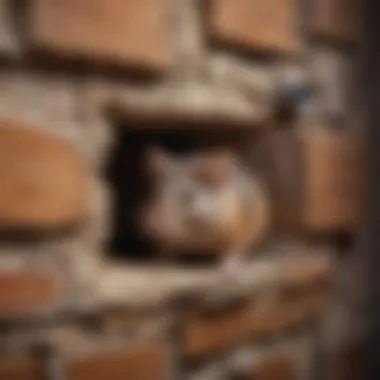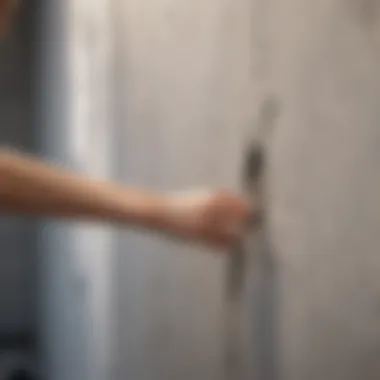Expert Guide: Dealing with a Mouse Infestation Inside Your Wall


Animal Species Profile
When it comes to dealing with a mouse in the wall, it is essential to understand the animal species involved. Mice are small rodents known for their quick movements and ability to squeeze into tight spaces due to their flexible bodies. These creatures have distinct physical characteristics, including their small size, pointed snouts, rounded ears, and long, hairless tails. Their natural habitat covers a wide range of environments, from fields and forests to urban areas worldwide. In terms of behavior, mice are highly adaptable creatures, exhibiting both solitary and social tendencies depending on the situation.
Navigating the methods of mouse removal requires insight into the species' characteristics and habits. By recognizing signs of infestation and understanding their behaviors, homeowners can adopt more effective strategies for resolving this common issue.
Understanding the Issue
Dealing with a mouse in the wall is a common concern for homeowners, necessitating a comprehensive understanding of the issue. By delving into the signs of a mouse infestation and the potential dangers it poses, individuals can proactively address the problem. Recognizing the importance of identifying key indicators of a mouse presence enables swift and effective action to prevent further complications within the household environment.
Recognizing the Signs of a Mouse in the Wall
When it comes to identifying the signs of a mouse in the wall, several crucial clues come into play, assisting in the detection of these elusive rodents. One prominent indicator is the presence of scratching noises emanating from within the walls. These noises, often occurring at night, can indicate the movement of mice as they navigate through the structure of the house. By paying attention to these auditory cues, homeowners can narrow down the location of the infestation, aiding in targeted interventions.
Gaps and Cracks
The identification of potential entry points, such as gaps and cracks, is paramount in fortifying the home against rodent intrusion. Gaps along walls, ceilings, or floors serve as prime entryways for mice, allowing them easy access to the interior spaces. By addressing these openings with suitable materials like steel wool or caulking, individuals can significantly reduce the likelihood of mice invading their living spaces.
Vents and Pipes
Another key entry point for mice includes vents and pipes that penetrate the walls of a building. These openings provide rodents with pathways to traverse between walls and access different areas of the house. Understanding the vulnerability posed by vents and pipes enables homeowners to implement preventive measures, such as installing mesh covers or sealing gaps around these entry points, effectively blocking off potential routes for mouse ingress.
Taking Action
Dealing with a mouse in the wall requires swift and decisive action to effectively address this common household issue. Taking action is crucial to prevent further infestation and potential damage to your property. By promptly addressing the presence of mice, you not only ensure the safety and hygiene of your home but also mitigate health risks associated with rodent infestations. Emphasizing proactive measures can lead to a more efficient resolution, maintaining a healthy living environment for you and your family.


Sealing Entry Points
To effectively combat a mouse infestation, sealing entry points is paramount. This prevents new rodents from entering your home and confines existing ones. Utilizing materials like steel wool offers a durable and impenetrable barrier against mice due to its toughness and resilience. Steel wool's ability to fill gaps and cracks efficiently further fortifies your home's defenses against rodent intrusion. However, caulking provides a more versatile option, sealing off potential entryways with a waterproof and long-lasting barrier. Though caulking may require periodic inspection and maintenance, its effectiveness in preventing rodent access cannot be overlooked or understated.
Using Steel Wool
Using steel wool as a barrier contributes significantly to maintaining a rodent-free environment. Its abrasive texture deters mice from chewing through, while its durability ensures long-lasting protection. The key characteristic of steel wool lies in its ability to block even the smallest openings effectively, making it a popular choice in rodent prevention strategies. Despite its efficacy, steel wool can pose challenges during installation due to its rigid nature, requiring precision and care to ensure thorough coverage. Understanding the advantages and disadvantages of steel wool aids in making an informed decision when implementing rodent-proofing measures.
Caulking
Caulking plays a vital role in sealing off potential entry points for mice. Its flexibility and weather-resistant properties make it an ideal choice for filling gaps and crevices around your home. The key characteristic of caulking lies in its ability to expand and contract with temperature changes, ensuring a secure seal over time. This popular choice for rodent-proofing offers ease of application but may require reapplication in high-traffic areas or exposed to harsh conditions. Recognizing the unique features of caulking and weighing its advantages and disadvantages are crucial steps in fortifying your home against pesky intruders.
Setting Traps
When dealing with a mouse infestation, setting traps is a humane and effective approach to controlling the rodent population within your premises. Snap traps provide an immediate and lethal solution to capturing mice rapidly. Their simplicity and high success rate make them a popular choice for homeowners seeking quick eradication of rodents. On the other hand, humane traps offer a non-lethal alternative, allowing for the capture and release of mice back into the wild. Their emphasis on compassionate removal aligns with ethical considerations, appealing to individuals seeking a more humane approach to pest control.
Snap Traps
Snap traps offer a straightforward yet efficient method of trapping mice in your home. Their spring-loaded mechanism delivers a swift and lethal outcome upon activation, ensuring a quick and humane end for captured rodents. The key characteristic of snap traps lies in their ability to target and eliminate mice without prolonged suffering, making them a preferred choice for those prioritizing swift eradication. Despite their effectiveness, snap traps require cautious placement and handling to prevent unintended harm to children, pets, or unintended targets. Understanding the advantages and disadvantages of snap traps aids in making an informed decision when selecting the appropriate method for rodent control.
Humane Traps
Utilizing humane traps provides a more compassionate approach to managing a mouse infestation. These traps safely capture mice without causing harm, allowing for their release in a remote location away from residential areas. The key characteristic of humane traps lies in their focus on rehoming captured rodents rather than extermination, appealing to individuals seeking a peaceful resolution to rodent issues. While humane traps promote ethical treatment of pests, they may require regular monitoring and relocation of captured mice, demanding additional time and effort from homeowners. Exploring the advantages and disadvantages of humane traps supports informed decision-making when adopting a more humane strategy towards rodent control.
Using Repellents
Implementing repellents serves as an additional layer of defense against mice, deterring them from dwelling within your living space. Natural repellents leverage scents and substances unpleasant to rodents, encouraging them to seek refuge elsewhere. Meanwhile, ultrasonic repellents emit sound waves that are disruptive to mice but harmless to humans and pets, providing a non-invasive solution to pest management. Balancing the advantages and disadvantages of each repellent type aids in selecting the most suitable option for safeguarding your home against unwanted rodent visitors.


Natural Repellents
Natural repellents offer a sustainable and eco-friendly approach to deterring mice from invading your home. Their use of fragrances like peppermint or essential oils creates an inhospitable environment for rodents, compelling them to vacate the premises. The key characteristic of natural repellents lies in their non-toxic nature and ease of application, providing a safe yet effective means of pest control. While natural repellents offer a chemical-free solution, their potency may diminish over time, necessitating regular reapplication to maintain efficacy. Understanding the advantages and disadvantages of natural repellents enables homeowners to integrate them seamlessly into their rodent prevention strategy.
Ultrasonic Repellents
Employing ultrasonic repellents introduces a technologically advanced approach to repelling mice from your home. These devices emit high-frequency sound waves that are disruptive to rodent communication and navigation, inducing discomfort that prompts rodents to vacate the premises. The key characteristic of ultrasonic repellents lies in their non-invasive and plug-and-play design, requiring minimal effort to set up and operate. While ultrasonic repellents offer a silent and efficient solution to rodent control, their effectiveness may be influenced by factors like room size and layout. Assessing the advantages and disadvantages of ultrasonic repellents aids in determining their suitability for integrating into your overall pest management strategy.
This comprehensive guide equips homeowners with the knowledge and strategies needed to tackle a mouse infestation effectively. By understanding the importance of taking action, sealing entry points, setting traps, and utilizing repellents, individuals can proactively address rodent issues within their homes. Whether adopting preventive measures or seeking humane removal methods, this guide empowers readers to protect their living spaces from unwanted rodent guests and maintain a safe and hygienic environment for themselves and their families.
Seeking Professional Help
Seeking professional help is a crucial step in effectively dealing with a mouse infestation. Pest control services offer specialized knowledge and tools to tackle the issue efficiently. By contacting professionals, homeowners can ensure a thorough evaluation of the infestation, leading to tailored treatment plans for eradication. Seeking professional help not only guarantees effective results but also promotes a safe and humane approach towards managing pest issues.
Contacting Pest Control Services
Evaluation
In the realm of addressing a mouse infestation, evaluation plays a pivotal role. Through detailed evaluation, pest control experts assess the extent of the infestation, pinpointing key areas of activity and entry points. This thorough assessment enables professionals to devise customized strategies for efficient eradication. Evaluation is a crucial first step that sets the foundation for developing targeted solutions to combat the mouse infestation in homes.
Treatment Plans
Crafting effective treatment plans is essential for successful pest management. These plans are tailored to address the specific characteristics of the mouse infestation, taking into account factors such as the severity of the issue and environmental considerations. Effective treatment plans not only focus on eradicating existing pests but also on implementing preventive measures to deter future infestations. By formulating detailed treatment plans, pest control services ensure a comprehensive and long-term solution to the mouse infestation problem.
Consulting Exterminators


Turning to exterminators for assistance brings a higher level of expertise to resolve mouse infestations. Exterminators specialize in conducting thorough inspections and implementing targeted extermination methods for effective results. Through detailed inspections, exterminators identify the root causes of the infestation, allowing for the implementation of precise and impactful strategies to eradicate the mice. Extermination methods employed by professionals are tailored to ensure the complete removal of pests while minimizing risks to the household environment.
Inspections
Inspections conducted by exterminators are meticulous and comprehensive, aiming to uncover all underlying issues contributing to the mouse infestation. By identifying entry points, sources of food, and nesting areas, inspections provide a holistic understanding of the infestation. This in-depth knowledge guides exterminators in developing strategic action plans to address the infestation effectively. Inspections are a fundamental step that sets the stage for successful pest elimination.
Extermination Methods
Exterminators employ a range of advanced extermination methods to eradicate mice from homes. From using targeted baits to implementing trapping mechanisms, these methods aim to exterminate pests efficiently. Extermination methods take into consideration the safety of residents and pets while ensuring maximum impact on pest populations. By utilizing specialized techniques, exterminators guarantee a swift and thorough removal of mice, restoring peace of mind to homeowners.
Preventing Future Infestations
When dealing with a mouse in the wall, the significance of preventing future infestations cannot be overstated. This section focuses on proactive measures to avoid recurring rodent issues, offering homeowners peace of mind and safeguarding their property. By implementing these strategies, individuals can create an inhospitable environment for mice, deterring them from establishing nests within walls or other areas of the home. Taking preventive actions is crucial in maintaining a rodent-free living space.
Maintaining Cleanliness
Regular Cleaning
An essential aspect of preventing future mouse infestations is regular cleaning. This practice involves maintaining cleanliness throughout the living space, which includes removing clutter, sweeping floors, and disinfecting surfaces. Regular cleaning not only eliminates potential food sources and hiding spots for mice but also disrupts their access to water and shelter. By upholding cleanliness standards, homeowners reduce the appeal of their homes to rodents, ultimately deterring infestations efficiently.
Proper Food Storage
Proper food storage plays a vital role in preventing mouse infestations. By securely storing food in airtight containers and promptly cleaning up food spills, individuals can limit access to sustenance for rodents. Effective food storage practices not only minimize the availability of food sources for mice but also contribute to overall kitchen hygiene. Maintaining a hygienic kitchen environment through proper food storage methods is key to mitigating the risk of attracting mice into living spaces.
Securing Your Home
Repairing Damages
Addressing structural damages in the home is imperative for preventing mouse infestations. By promptly repairing cracks, gaps, and other vulnerabilities in the building's exterior, homeowners can eliminate potential entry points for rodents. Repairing damages not only reinforces the home's structural integrity but also acts as a barrier against unwanted intrusions by pests. Home repairs serve as a proactive measure in fortifying properties against rodent infiltration.
Landscaping Tips
Strategic landscaping can aid in deterring mice from entering the premises. By maintaining a clear perimeter around the house, trimming vegetation, and removing debris, homeowners can reduce harborage opportunities for rodents. Landscaping tips such as keeping shrubs and trees from touching the house and storing firewood away from the structure can help prevent mice from finding refuge near the home. Implementing these landscaping practices enhances the property's defenses against potential rodent invasions.







